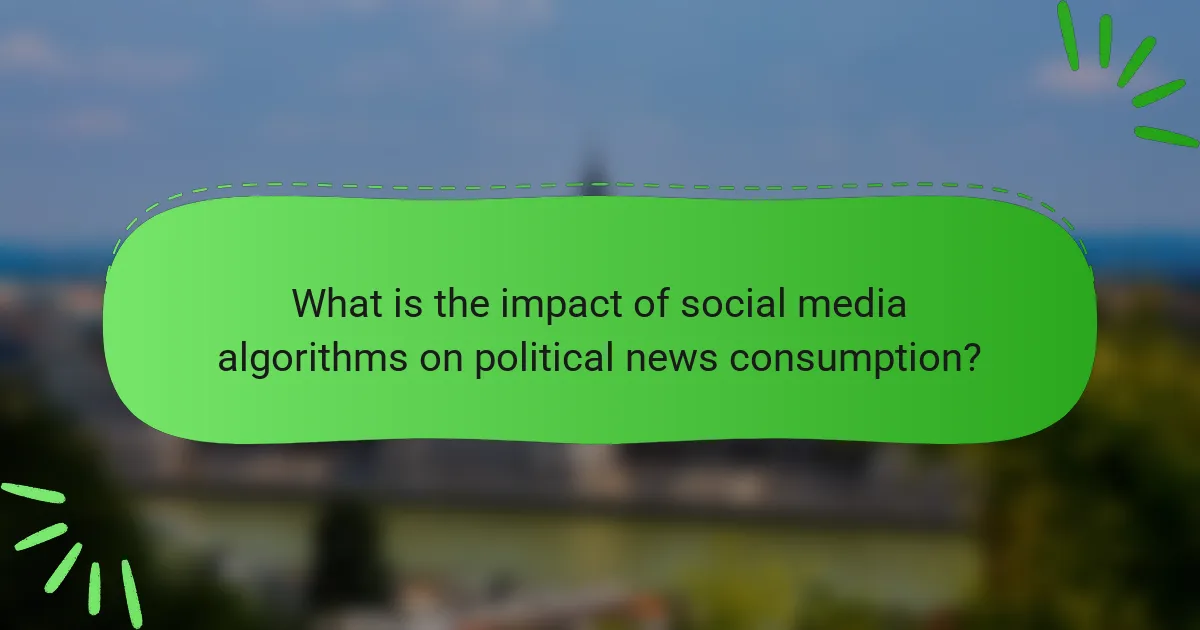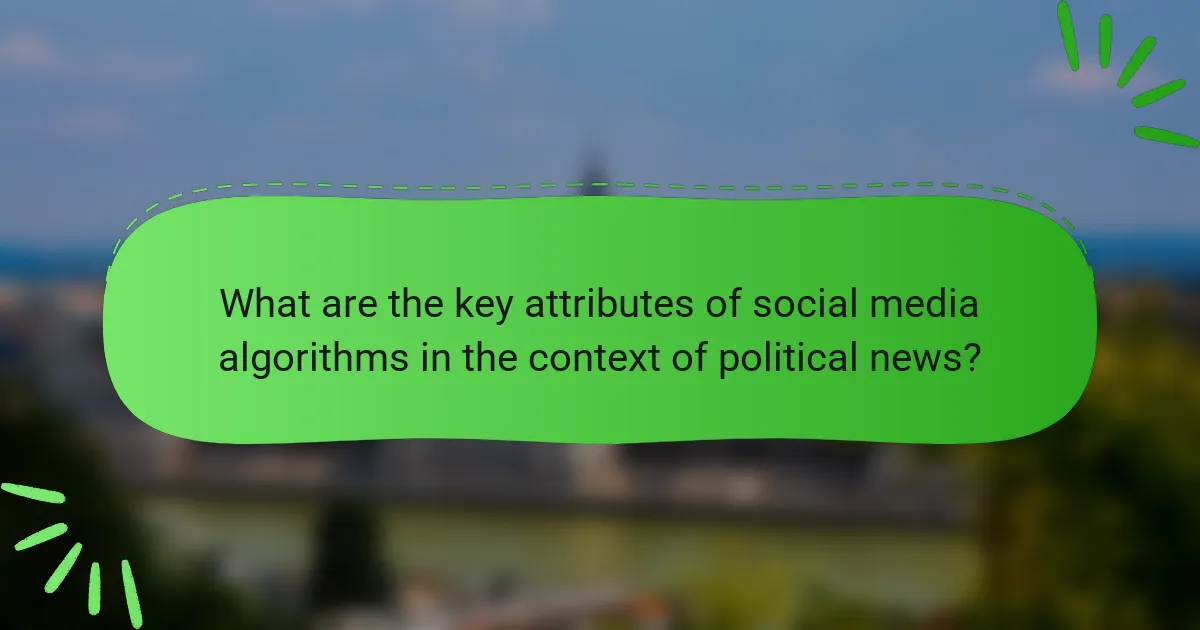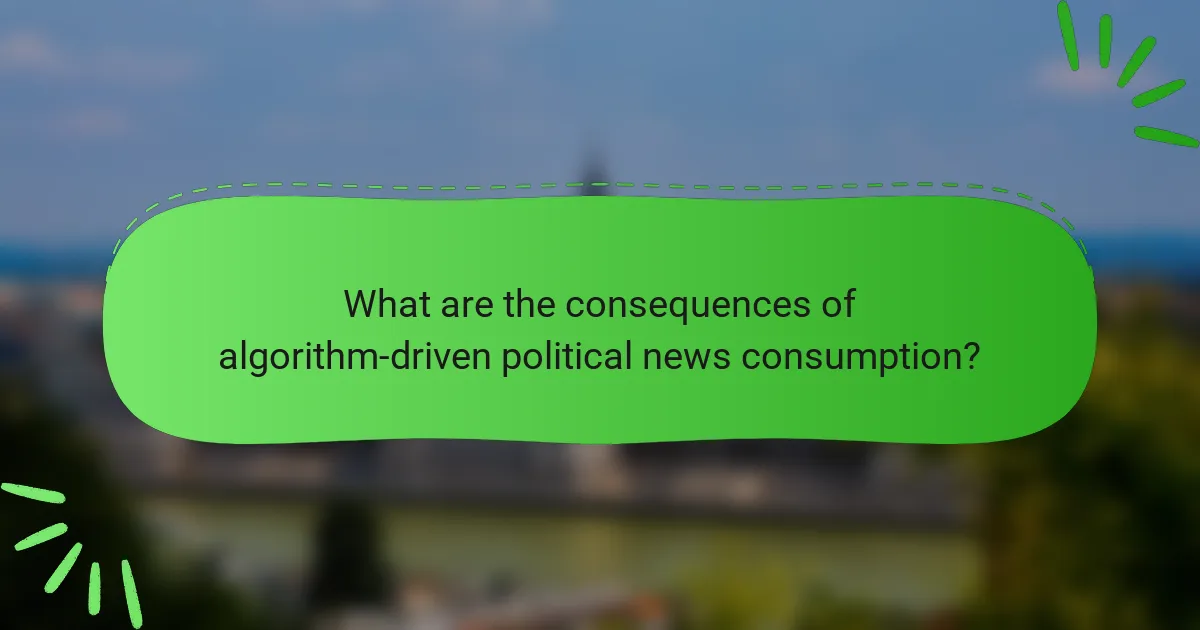Social media algorithms play a crucial role in shaping political news consumption by prioritizing content based on user engagement, relevance, and personalization. These algorithms analyze user behavior to deliver news articles that align with individual preferences, often resulting in echo chambers that limit exposure to diverse viewpoints. Research indicates that this algorithm-driven approach can distort public perceptions of political consensus and amplify partisan perspectives. A Pew Research Center study highlights that 64% of Americans perceive social media’s impact on political discourse as predominantly negative, suggesting that algorithmic filtering contributes to polarization and misinformation. Overall, the influence of social media algorithms complicates informed decision-making and affects trust in traditional media sources.

What is the impact of social media algorithms on political news consumption?
Social media algorithms significantly influence political news consumption. These algorithms prioritize content based on user engagement and preferences. As a result, users are more likely to see news that aligns with their existing beliefs. This phenomenon can lead to echo chambers, where exposure to diverse viewpoints is limited. Research indicates that algorithm-driven feeds can distort perceptions of political consensus. A study by the Pew Research Center found that 64% of Americans believe social media platforms have a negative impact on political discourse. Additionally, algorithms can amplify sensational or misleading content, further complicating informed decision-making. Overall, social media algorithms shape the political landscape by determining which news reaches users.
How do social media algorithms influence the visibility of political news?
Social media algorithms significantly influence the visibility of political news by determining what content is shown to users. These algorithms prioritize posts based on user engagement, relevance, and recency. Political news that garners high interaction rates, such as likes and shares, is more likely to appear in users’ feeds. This creates a feedback loop where popular political content receives increased visibility. Studies indicate that algorithms can create echo chambers, reinforcing users’ existing beliefs. For instance, a 2020 study by the Pew Research Center found that users often see political news aligned with their views due to algorithmic filtering. Consequently, this can limit exposure to diverse perspectives on political issues.
What factors determine how algorithms prioritize political content?
Algorithms prioritize political content based on user engagement, relevance, and recency. User engagement metrics include likes, shares, and comments. Higher engagement signals greater interest, prompting algorithms to prioritize that content. Relevance is determined by user interests and previous interactions. Algorithms analyze user behavior to tailor content accordingly. Recency ensures that the most current political news is surfaced. Timely information is crucial in political discourse. Additionally, the source’s credibility can influence prioritization. Algorithms may favor content from established news outlets over lesser-known sources. These factors collectively shape the visibility of political content on social media platforms.
How do user interactions shape algorithmic outcomes for political news?
User interactions significantly shape algorithmic outcomes for political news. Algorithms prioritize content based on user engagement metrics. Likes, shares, and comments signal to algorithms which stories are popular. Higher engagement leads to increased visibility of those political news articles. This creates a feedback loop, amplifying certain narratives. Research indicates that algorithms favor emotionally charged content. Studies show that sensational political news receives more interaction. Consequently, user behavior directly influences the type of political news that becomes prominent.
Why is understanding social media algorithms important for political engagement?
Understanding social media algorithms is crucial for political engagement because they determine content visibility. Algorithms prioritize posts based on user interactions, relevance, and engagement metrics. This affects which political messages are amplified or suppressed. For instance, a study by the Pew Research Center found that 64% of Americans believe social media has a significant impact on political opinions. By understanding these algorithms, individuals and organizations can tailor their content to reach wider audiences. This strategic approach enhances the likelihood of mobilizing supporters and influencing public discourse.
How do algorithms affect public perception of political issues?
Algorithms influence public perception of political issues by curating content based on user engagement. These algorithms prioritize information that aligns with user interests and behaviors. As a result, users often encounter echo chambers that reinforce existing beliefs. A study by the Pew Research Center found that social media platforms significantly shape political news consumption patterns. Users are more likely to share content that resonates with their views, further amplifying specific narratives. This selective exposure can distort perceptions of political reality. Algorithms also contribute to misinformation spread by favoring sensational content. Consequently, public discourse may become polarized due to algorithm-driven content curation.
What role do algorithms play in the polarization of political opinions?
Algorithms play a significant role in the polarization of political opinions by curating content that aligns with users’ existing beliefs. Social media platforms utilize algorithms to analyze user behavior and preferences. This analysis results in the promotion of content that reinforces users’ viewpoints. Consequently, individuals are exposed to a limited range of perspectives. Research indicates that such echo chambers can deepen ideological divides. A study by Bakshy et al. (2015) found that Facebook’s algorithm tended to amplify partisan content. This amplification contributes to a fragmented information landscape. As users engage more with like-minded content, their political views become more extreme.

What are the key attributes of social media algorithms in the context of political news?
Social media algorithms in the context of political news prioritize content based on user engagement, relevance, and personalization. These algorithms analyze user behavior to determine which political news articles are most likely to attract attention. Engagement metrics such as likes, shares, and comments significantly influence content visibility. Relevance is assessed through the user’s interests, previous interactions, and demographic data. Personalization allows algorithms to tailor news feeds to individual preferences, potentially creating echo chambers. Research shows that algorithmic filtering can amplify partisan perspectives, affecting public discourse. A study by the Pew Research Center found that 64% of Americans believe social media has a mostly negative effect on political discourse.
What types of algorithms are commonly used on social media platforms?
Social media platforms commonly use recommendation algorithms, ranking algorithms, and engagement algorithms. Recommendation algorithms suggest content to users based on their interests and previous interactions. Ranking algorithms prioritize posts in a user’s feed according to relevance, popularity, or recency. Engagement algorithms analyze user interactions to predict and display content that will generate more engagement. These algorithms utilize machine learning techniques to improve their accuracy over time. For instance, Facebook’s algorithm focuses on maximizing user engagement by showing posts that generate comments and shares. Twitter’s algorithm emphasizes recency and engagement to keep users informed of trending topics. These algorithm types significantly influence how political news is consumed on social media.
How do different algorithms impact the dissemination of political information?
Different algorithms significantly influence the dissemination of political information. Algorithms determine what content users see on social media platforms. They prioritize posts based on user engagement, which can skew visibility toward sensational or polarizing content. For instance, Facebook’s algorithm promotes posts that generate high interaction rates. This can lead to echo chambers, where users are exposed primarily to viewpoints that reinforce their beliefs. Research indicates that algorithmic biases can amplify misinformation, affecting public opinion and voter behavior. A study by the Pew Research Center found that algorithmic filtering can alter perceptions of political issues among different demographics. Thus, the design and function of algorithms play a crucial role in shaping political discourse online.
What are the unique features of algorithms that target political news specifically?
Algorithms that target political news specifically prioritize content based on user engagement metrics. These algorithms analyze interactions such as likes, shares, and comments to determine relevance. They often amplify sensational or emotionally charged headlines to increase user engagement. Additionally, these algorithms may filter content based on users’ political affiliations and past behavior. This personalization can create echo chambers, reinforcing existing beliefs. Algorithms also adapt in real-time to trending topics in political discourse. They utilize natural language processing to identify political sentiment in posts. The unique combination of these features shapes how users consume and engage with political news on social media platforms.
How do algorithms adapt to user behavior in political news consumption?
Algorithms adapt to user behavior in political news consumption by analyzing user interactions. They track metrics such as clicks, shares, and time spent on articles. Based on this data, algorithms prioritize content that aligns with users’ preferences. For instance, if a user frequently engages with conservative articles, the algorithm will show more similar content. This process is known as personalization. Research indicates that personalized news feeds can create echo chambers. A study by the Pew Research Center found that 62% of users are exposed primarily to news that reinforces their existing beliefs. Thus, algorithms significantly influence the political news landscape by tailoring content to user behavior.
What patterns of user engagement are most influential in shaping algorithmic responses?
User engagement patterns that significantly influence algorithmic responses include likes, shares, comments, and watch time. Algorithms prioritize content that generates high interaction rates. For instance, posts with more shares are often displayed more prominently. Similarly, comments indicate user interest and can lead to increased visibility of the content.
Research shows that engagement metrics directly impact algorithmic ranking on platforms like Facebook and Twitter. A study by the Pew Research Center found that posts with higher engagement lead to greater reach and visibility. This means that content creators often tailor their posts to encourage these interactions.
In summary, the most influential patterns of user engagement are those that generate interactions, as they drive algorithmic prioritization of content.
How do algorithms learn from user feedback regarding political content?
Algorithms learn from user feedback regarding political content by analyzing user interactions. These interactions include likes, shares, comments, and time spent on specific content. The algorithms adjust their recommendations based on this data. For instance, if users frequently engage with particular political topics, the algorithms prioritize similar content in their feeds. This process is known as reinforcement learning. Algorithms utilize machine learning models to identify patterns in user behavior. They continuously refine their recommendations to enhance user satisfaction. Research shows that user engagement significantly influences algorithmic adjustments. A study by Bakshy et al. (2015) found that social media algorithms adapt based on user feedback, impacting political content visibility.

What are the consequences of algorithm-driven political news consumption?
Algorithm-driven political news consumption can lead to polarization and misinformation. Users often receive content that reinforces their existing beliefs. This creates echo chambers, limiting exposure to diverse perspectives. Algorithms prioritize engagement, which can amplify sensational or misleading information. Research shows that algorithmic filtering can distort public understanding of political issues. A study by the Pew Research Center found that 64% of Americans believe social media has a mostly negative effect on democracy. Additionally, algorithm-driven news consumption can decrease trust in traditional media sources. This results in a fragmented information landscape, complicating informed decision-making during elections.
What are the potential risks associated with algorithmic curation of political news?
Algorithmic curation of political news poses several potential risks. One significant risk is the reinforcement of echo chambers. Algorithms often prioritize content that aligns with users’ existing beliefs. This can lead to a narrow perspective on political issues. Another risk is the spread of misinformation. Algorithms may inadvertently promote false or misleading news stories. This can distort public understanding of important political topics. Additionally, algorithmic bias can occur. Algorithms can reflect the biases of their creators or training data. This may result in unequal representation of political viewpoints. Lastly, algorithmic curation can diminish critical thinking. Users may rely on algorithms for news selection instead of seeking diverse sources. This can hinder informed civic engagement.
How can misinformation spread through algorithmic processes?
Misinformation can spread through algorithmic processes by prioritizing engagement over accuracy. Social media algorithms are designed to maximize user interaction. They often promote content that generates strong emotional responses. This can lead to sensationalized or misleading information being amplified. Studies show that false information spreads faster than true information on these platforms. According to a 2018 study by Vosoughi, Roy, and Aral, false news stories are 70% more likely to be retweeted than true stories. Algorithms favor content that keeps users engaged, regardless of its truthfulness. This creates an environment where misinformation can flourish unchecked.
What impact does algorithmic bias have on political discourse?
Algorithmic bias significantly influences political discourse by shaping the information users receive. This bias can lead to the amplification of certain viewpoints while suppressing others. For example, algorithms prioritize content that aligns with users’ preferences, creating echo chambers. These echo chambers can polarize public opinion and hinder constructive dialogue. Research from the Pew Research Center indicates that social media users often encounter news that reinforces their existing beliefs. Consequently, this can distort perceptions of political realities. Additionally, algorithmic bias may contribute to misinformation spreading more rapidly. This misinformation can further complicate political discussions and decision-making processes.
What strategies can users employ to navigate social media algorithms effectively?
Users can navigate social media algorithms effectively by curating their content interactions. Engaging consistently with preferred content helps signal to algorithms what users want to see. Following specific accounts that align with user interests enhances relevant content visibility. Users should utilize features like ‘see first’ or notifications for key accounts. Regularly updating preferences and interests can refine algorithmic suggestions. Engaging with diverse content types, such as videos and articles, can broaden exposure. Additionally, users can participate in discussions to increase visibility in algorithmic feeds. Research indicates that active engagement leads to a more tailored content experience.
How can users diversify their news sources to combat algorithmic limitations?
Users can diversify their news sources by actively seeking information from various platforms. This includes reading content from independent news websites, subscribing to newsletters, and following diverse social media accounts. Engaging with international news outlets can also provide different perspectives. Utilizing news aggregator apps can help compile articles from multiple sources. Additionally, participating in community forums can expose users to grassroots information. Research indicates that exposure to varied viewpoints enhances critical thinking and reduces echo chambers. A study by the Pew Research Center found that diverse news consumption aids in a more informed public.
What practices can enhance critical engagement with political news on social media?
Practices that can enhance critical engagement with political news on social media include diversifying information sources. Engaging with a variety of viewpoints promotes a well-rounded understanding of issues. Fact-checking claims before sharing can prevent the spread of misinformation. Analyzing the credibility of sources is crucial for informed discussions. Participating in discussions with a focus on civil discourse encourages constructive dialogue. Reflecting on personal biases helps individuals recognize their influence on perceptions. Utilizing tools that track media bias can provide insights into the framing of news. These practices collectively foster a more critical approach to consuming political news on social media.
The main entity of this article is social media algorithms and their impact on political news consumption. The article examines how these algorithms prioritize content based on user engagement, relevance, and recency, leading to echo chambers that reinforce existing beliefs. It highlights the consequences of algorithm-driven news consumption, including polarization, misinformation, and the distortion of public perception. Additionally, the article discusses user interactions, algorithmic bias, and strategies for diversifying news sources to enhance critical engagement with political content on social media platforms.